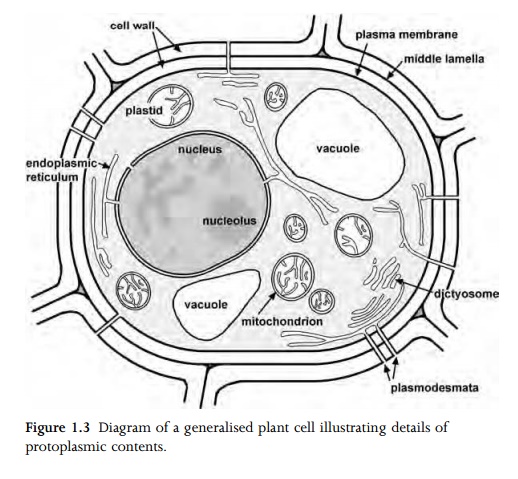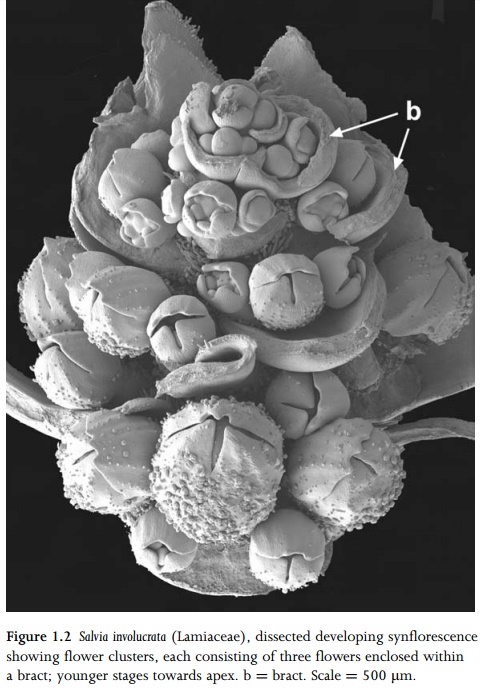Chapter: Anatomy of Flowering Plants: An Introduction to Structure and Development : Organs, Cells and Tissues
Plant cells
Cells
Plant cells typically have a cell wall containing a living protoplast
(Fig. 1.3). The layer that contacts the walls of adjacent cells is termed the
middle lamella. Following cessation of growth, many cells develop a secondary
cell wall which is deposited on the inside surface of the primary wall. Both
primary and secondary walls consist of cellulose microfibrils embedded in a
matrix and ori-ented in different directions. Secondary cell walls consist
mostly of cellulose, but primary walls commonly contain a high proportion of
hemicelluloses in the gel-like matrix, affording a greater degree of plasticity
to the wall of the growing cell. The secondary wall can also contain deposits
of lignin (in sclerenchymatous cells) or suberin (in many periderm cells), and
often appears lamellated.


Thin areas of the primary wall, which usually correspond with thin areas of the walls of neighbouring cells, are primary pit fields, and usually have protoplasmic strands (plasmodesmata) passing through them, connecting the protoplasts of neighbouring cells. The connected living protoplasts are collectively termed the sym-plast. Primary pit fields often remain as thin areas of the wall even after a secondary wall has been deposited, and are then termed pits, or pit-pairs if there are two pits connecting adjacent cells. Pits may be simple, as in most parenchyma cells, or bordered, as in tracheary elements. In simple pits the pit cavity is of more or less uniform width, whereas in bordered pits the secondary wall arches over the pit cavity so that the opening to the cavity is rela-tively narrow. Through a light microscope the outer rim of the primary pit field appears as a border around the pit opening.
The cell protoplast is contained within a plasma membrane. It consists
of cytoplasm that encloses bodies such as the nucleus, plastids and
mitochondria, and also non-protoplasmic contents such as oil, starch or
crystals. The nucleus, which is bounded by a nuclear membrane, often contains
one or more recognizable bodies (nucleoli) together with the chromatin in the
nuclear sap. During cell division the chromatin becomes organized into
chromosomes. Most cells possess a single nucleus, but examples of multinucleate
cells (coenocytes) include the non-articulated laticifers found in many plant
families. Such cells elongate and penetrate established tissues by intrusive tip
growth,in which the cell apices secrete
enzymes that dissolve the middle lamellae of neighbouring cells; bifurcation
occurs when they encounter an obstacle.
Mitochondria and plastids are surrounded by double mem-branes. Plastids
are larger than mitochondria, and are classified into different types depending
on their specialized role. For example, chloroplasts are plastids that contain
chlorophyll within a system of lamellae that are stacked to form grana; this is
the site of photosynthesis. Chloroplasts occur in all green cells, but are most
abundant in the leaf mesophyll, which is the primary photosynthetic tissue.
Membranes occur widely throughout the cytoplasm, sometimes bounding a series of
cavities. For example, the endoplasmic reticulum is a continuous membrane-bound
system of flattened sacs and tubules, sometimes coated with ribosomal
particles. Dictyosomes are systems of sacs associated with secretory activity.
Vacuoles are cavities in the cytoplasm; they are usually colourless and contain
a watery fluid. Their size and shape varies in different cell types, and also
changes during the life of a cell.
Related Topics